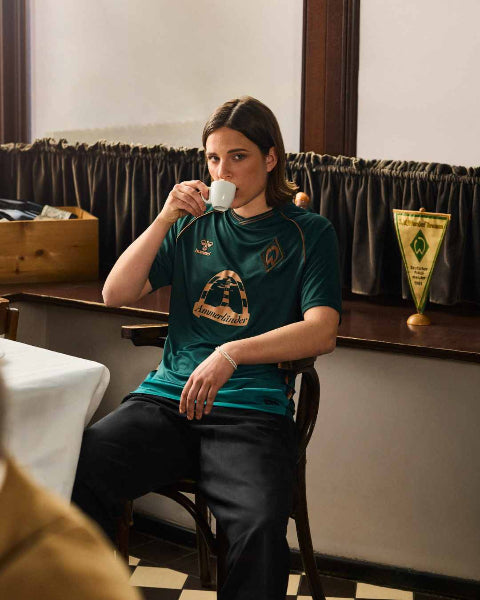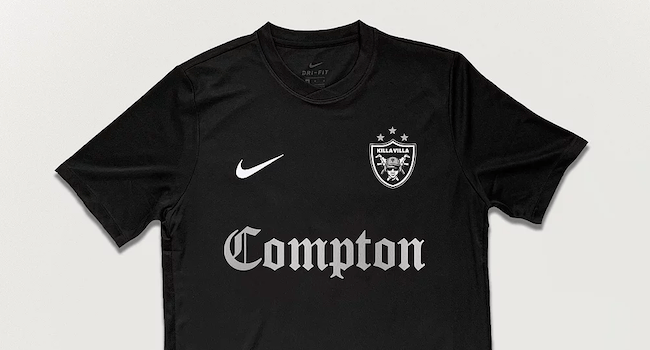Recently added
Vintage shirts
Concept kits
Legends
How to spot a fake football shirt in 2025 | Complete guide
by Mike Maxwell February 05, 2022 6 min read

Welcome back to Collectors Club. Last time round we looked closely as the age old problem of washing football shirts, and today we tackle a subject that’s arguably even more of a problem. Fake football shirts.
Yes, if you’ve spent even just a day amongst the football shirt community, you’ll have no doubt encountered a question about fakes. To many people, a fake football shirt is a means to an end, an opportunity to ‘get’ the shirt of their dreams at a fraction of the price.
To a collector though, a fake shirt is as good as a tea towel. Any hunt on marketplaces like eBay and Depop becomes an exercise in dodgy counterfeit shirts, and if anything the tightrope walk only seems to be getting longer and more difficult.
How to spot fake football shirts by brand
| Nike | Kappa | adidas | Puma |
Even experienced collectors can be forced to take a second look with what appears to be an increasing quality when it comes to the production of fakes, and so for Collectors Club we couldn’t leave the issue any longer.
As before, we’re enlisting the help of members of the community. Firstly we welcome Ellis Platten to the series. Ellis runs the highly successful YouTube channel AwayDays, and this year has seen the creator branch out with a range of popular shirt related videos!
Ellis is joined by the returning Roger Sharrock, who runs Cult Football. Read the guide below and if you want to check a shirt use our free shirt authenticity checker here
How to spot a fake football shirt by club?
| Arsenal | Manchester United | England |
How to spot fake football shirts
1. Use trusted sellers
Fake shirts are increasingly hard to avoid on marketplaces like eBay and Depop. For frustrating reasons no one can understand, these marketplaces appear to do very little when it comes to shutting down even the most obvious of fake sellers.
Ellis: People buy them from everywhere these days, fake shirt sites, Depop and eBay are incredibly full of them sadly.
Over time, you can learn how to navigate this often murky sea, but even the most experienced sellers can get caught out. The most fool proof method of avoiding fakes is to shop with trusted sellers.
Look out for clear indications of a trusted seller, including reviews, unique imagery and copy, and ideally some sort of social presence.
Roger: I think it has now become common knowledge that there’s a few websites where the vast majority of fakes originate from.
In the UK shirts then appear to be sold on through online marketplaces like eBay and apps (ESPECIALLY DEPOP) have now become flooded with fakes. It’s clearly something that needs addressing. No one from within eBay or Depop seem to take any notice of reports which in turn is seriously tainting the experience of searching for shirts on these sites.
2. Understand the terminology around fake football shirts
A lot of people are confused by the term “replica”. The phrase should simply be used to designate a shirt that is sold to fans through official channels, at a lower price point than a player issue shirt. Some brands or teams only wear and sell replica shirts, let alone any fancy player issue stuff.
However, the term replica is sometimes used as a bit of a catch all to include… well basically anything. Dodgy sellers will call a shirt replica, when in reality the shirts they are selling are at best a retro remake, or at worst, a complete fake.
Look out for other terms like “retro”, which can be used wrongly and unhelpfully.
Ellis: The term replica is becoming more and more prominent from companies and sellers to try and trick people into buying shirts.
Roger: The term replica seems to have been drastically lost over recent times. To me as someone in their 30s a replica football kit was the original term for a store bought shirt/kit in my youth. However “replica” now along with quite a few other names have become the new word for fake.
3. If the price is too good to be true, it’s too good to be true
The most consistent giveaway when it comes to fake shirts is the price, and though it’s a cliché, if the price looks too good to be true, it’s probably too good to be true.
There are a number key touchpoints to be aware of in regards to price. The first is soon after release. If a shirt has just been released, it will never appear on a site for 50% cheaper than retail price (check the club or brand store to see the retail price). It’s unlikely to appear with even a 10% discount (ignoring things like site wide voucher codes etc.), but in general it’s best to compare with multiple sources.
Ellis: Many ‘retro fakes’ come with tags and are listed for around £20 which is laughable in the current kit climate.
You should also do your due diligence when it comes to vintage shirts. Even just a quick Google of the shirt you’re looking to buy can quickly put a price you see into context. Desperate for an Ajax 1989 away shirt, and somewhere is listing it for just £50? You’re just paying extra for a fake, as you’d struggle to find it legitimately for under £200.
On a similar note, multiple size options of a vintage shirt on the older end of the spectrum (pre-2000) are usually an indication of a fake. You do occasionally see things like deadstock drops with multiple sizes, but in general you should always think twice if a rare shirt is available in all sizes from XS-XXL.
4. Product codes are invaluable
Some fakes can trick even the most discerning collector, but if you’re struggling to identify a fake shirt you can always ask to see the product codes. These can usually be found on the inside of the shirt near the bottom, and a quick Google of the code will reveal whether the shirt you’re looking at is legit or not.
Roger: A good way to check whether a shirt is fake or not is to search for the product item codes.
Ellis: The inside tags of an item and searching product codes is the sure fire way to avoid being stung.
If anyone refuses to show you the labels, that’s an immediate flag. If anyone has cut off the label, proceed at your own risk.
Try it out on the collection you already have, and hopefully you won’t find any nasty surprises!
5. Fake football shirts never make sense for a collector
Ultimately as a collector, a fake shirt is a bad investment. One of the best things about collecting shirts is that you have the opportunity to sell on your shirts to fund future purchases. In most cases, football shirts go up in value over time too, so your £30 spend today could easily translate into £100 down the line if you invest wisely (or at least that’s what I tell my wife!).
With a fake shirt, you have no resale value at all no matter how good the shirt. Of course, many people don’t plan to ever sell their shirts, and simply want to buy a shirt for the team they support. In this situation though, I would counsel that fans would be supporting their club by buying from them, or an affiliated partner.
Yes, these are incredibly slim margins in the grand scheme of things, but illegal shirt markets only hurt clubs and brands as a whole, not to mention they are often linked to serious criminal activity.
Roger: Quality wise a fake shirt will rarely stand up. Then there are the legalities surrounding fake items. It’s often said the counterfeit market funds further black market activity. It’s almost certainly untaxed so doesn’t contribute at all to the economy and it can also weaken a clubs brand and image. Lets not forget a fake shirt also holds no real value, so if you’re looking to hold onto it to sell in the future it will be a waste of time.
Whether you consider yourself a collector or not, you should stop and think before you grab up that shirt everyone is talking about for £15, or a full kit for your child’s favourite team for a tenner.
6. Always check the label
There is a brilliant video below by the Kit Breakdown where they interview Ben Houston, an expert in tackling counterfeits. He gives a great tip for spotting a fake by checking the label. If the label has pen / pencil written on it, this it a good tell it is fake. Counter fit manufacturers often mark labels with pen or pencil(as they count how many. So when checking your vintage shirt look out for markings on the label.
Fake shirts will always be a risk, and if anything we can attribute their rise in prominence to the fact that shirts are becoming more popular. If you’re someone who wants to avoid fakes though, you can hopefully feel more confident when hunting for your next addition.
Thanks again to Roger and to Ellis for helping us out with this latest part of Collectors Club. We have a range of upcoming topics already lined up and a number of different guests to hear from, so don’t go anywhere.
Our most popular collections of authentic football shirts
| Vintage football shirts | Arsenal | Manchester United | Liverpool |
If you enjoyed this blog on fake football shirts then why not sign-up to our weekly Collectors Club Newsletter to receive more great tips each week? You can sign-up here.
Sidebar
- Premier League football shirts
-
Other English clubs
- Birmingham City
- Blackburn Rovers
- Charlton Athletic
- Coventry City
- Derby County
- Hull City
- Ipswich Town
- Leicester City
- Middlesbrough
- Millwall
- Norwich City
- Portsmouth
- Preston North End
- Queens Park Rangers
- Sheffield United
- Sheffield Wednesday
- Southampton
- Stoke City
- Swansea City
- Watford
- West Bromwich Albion
- Scottish clubs
- Italian club shirts
- Spanish club shirts
- German club shirts
- International
- French club shirts
- Rest of the world
-
Legends
- Adriano
- Alessandro Del Piero
- Andrey Arshavin
- Alvaro Recoba
- Bobby Moore
- Bryan Robson
- Bukayo Saka
- Clarence Seedorf
- Cristian Vieri
- Cristiano Ronaldo
- David Beckham
- David James
- David Seaman
- David Ginola
- Dennis Wise
- Dennis Bergkamp
- Didier Drogba
- Dimitar Berbatov
- Diego Maradona
- Edgar Davids
- Eric Cantona
- Fernando Torres
- Freddie Ljungberg
- Gabriel Batistuta
- Gianluca Vialli
- Gianluigi Buffon
- Giovanni Elber
- Frank Lampard
- Francecso Totti
- Haaland
- Harry Kane
- Hidetoshi Nakata
- Ian Wright
- Jari Litmanen
- Ji Sung Park
- Juninho
- Jurgen Klinsmann
- Kaka
- Landon Donovan
- Lionel Messi
- Lothar Mattaus
- Luis Figo
- Mark Viduka
- Matt Le Tissier
- Mesut Özil
- Michael Owen
- Mikel Arteta
- Neymar
- Nicolas Anelka
- Nwankwo Kanu
- Paolo Di Canio
- Paolo Maldini
- Patrick Vieira
- Rafael Van der Vaart
- Raul
- Riquelme
- Rivaldo
- Robert Pires
- Roberto Baggio
- Robbie Fowler
- Ronaldo Nazario
- Ronaldinho
- Roy Keane
- Rudi Voller
- Ruud Gullit
- Ryan Giggs
- Santi Carzola
- Steve Bull
- Steven Gerrard
- Teddy Sheringham
- Thierry Henry
- Tony Adams
- Toto Schillaci
- Tugay
- Wayne Rooney
- Xabi Alonso
- Zinedine Zidane
- Zola
- Brands
Subscribe
Sign up to get the latest on sales, new releases and more …














